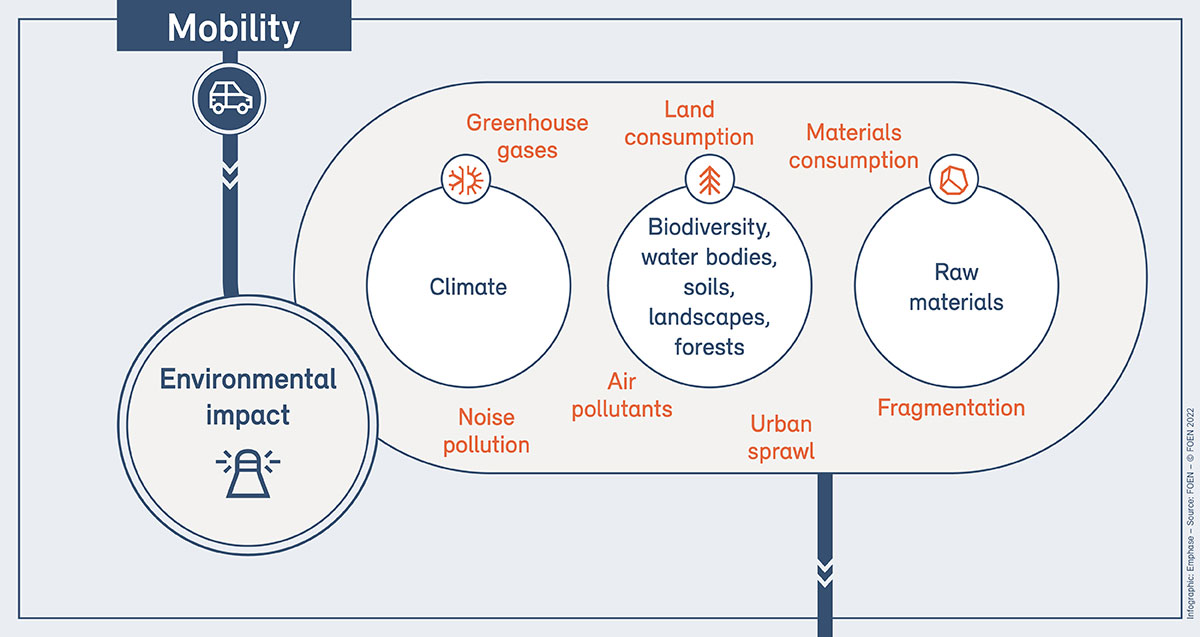Mobility means quality of life. However, it also has a significant effect on human health and the environment. Its principal impacts include greenhouse gases, air pollutants, noise and its consumption of land and materials. Preservation of an environment that is as intact as possible and achievement of the climate targets and the goal of becoming carbon neutral by 2050 are currently at odds with the mobility requirements and the growing volumes of passenger and freight traffic.

Transport performance in Switzerland has been continually rising since the mid-1990s. Some three quarters of passenger transport performance (land transport only) is accounted for by motorised road transport. The measures introduced to combat the COVID-19 pandemic, such as the working from home mandate, led to a decline in transport performance in Switzerland in 2020 for the first time since the mid-1990s.
But the residents of Switzerland are not only highly mobile on land: they also fly a lot, with the average number of flights per capita and year rising by 43% to 0.83 between 2010 and 2015.
Due to increasing traffic volumes, in the past the environmental impacts could be only partially reduced through technological advances. Transport still causes a high level of environmental impacts.
Climate, air, noise
The majority of the environmental impacts of the mobility can be attributed to conventional motorised road traffic. This causes most of the emitted greenhouse gases and air pollutants. Road traffic is also the biggest source of noise, well ahead of rail transport and aviation.
A third of all greenhouse gases emitted in Switzerland originate from motorised transport. In 2020, the emissions generated by the transport sector fell year-on-year by almost 9% and were 8% below the 1990 baseline. The target 10% reduction was therefore missed, even though transport volumes declined massively during the course of the coronavirus pandemic. These figures do not include emissions from international air transport.
While the blending of biofuels has increased in recent years, it accounted for just under 4% of total fuel sales in 2020. More efficient vehicles have also resulted in decreasing CO2 emissions per kilometre. However, the increase in kilometres covered cancelled out these positive effects.
But it is not only road transport that emits large amounts of greenhouse gases, aviation does too. On average, people in Switzerland fly twice as often as people in neighbouring countries, and also more than people in the United States. But international aviation does not currently fall under Switzerland's reduction target.
Damage to nature and the environment, the health impacts caused by noise and emissions, as well as accidents cause what are known as external costs, in other words costs that are not borne directly by transport users. In 2019, these costs amounted to just under CHF 14 billion: 70% from motorised road traffic.
Biodiversity, soils, landscapes
Soil sealing and the fragmentation of habitats by infrastructures, such as roads or settlements, are one of the main causes of the decline in biodiversity. Transport infrastructures are – together with housing – also a fundamental cause of urban sprawl.
Housing, work, transport and recreational facilities take up around 8% of Switzerland’s national territory. Of these settlement areas, traffic areas make up an important share at 30%
Inward urban development has slowed the urban sprawl to some degree, but soil sealing has picked up pace again over the past decade. Settlement and infrastructure growth are the reasons, driven by rising demand for living and working space, as well as transport services.
As a result of new transport facilities, landscape fragmentation increased further between 2014 and 2020, although the rate has slowed in comparison with the 1980s and 1990s. Urban sprawl across the landscape remains extensive, but settlement growth is actually slowing down.
Raw materials
Switzerland uses a great deal of resources (raw materials, including energy sources) which subsequently turn into waste. 7 million tonnes of resources per year are used for mobility, 88% of which is in the form of fuel.
While the total environmental impact of Swiss mobility is dominated by energy use, whose share is about three-fourths, materials make up about a one-fourth share. Among the materials, metals in particular (14.9% overall) cause considerable ecological effects. Despite their small share of the mass, i.e. 0.1%, electronics also make up a significant share, i.e. 4.3%, of the total environmental impact.
The trend towards electric vehicles means the recycling or reconditioning of batteries will become more important, as will the recovery of rare technical metals.
Further information
Links
Documents
Environmental impact of passenger cars with different powertrain types (PDF, 691 kB, 27.04.2023)Summary, full version available in german and french.
Last modification 27.04.2023





